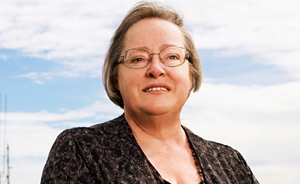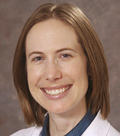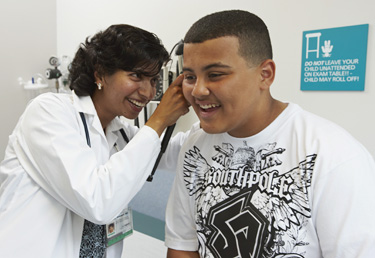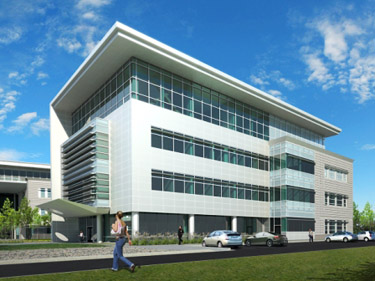
On the homepage: Standing at Woodley Island Marina near her home just south of Eureka, Calif., Alice Thompson consulted a UC Davis endocrinologist who helped her manage her diabetes better via a telemedicine connection. Linking experts with small rural communities to provide specialty medicine is a key goal of the California Telehealth Network.
Posted March 2, 2011
A diabetic for 40 years, Alice Thompson was injecting nearly 300 units of insulin per day – sometimes more.
“My blood sugar was sometimes so high it wouldn’t register on the monitor,” she says. “Diet and exercise weren’t helping, my vision was poor, and my kidneys were deteriorating.”
Thompson needed to consult with a specialist, but the 350 miles between her home and Sacramento was a long distance. The Telehealth and Visiting Specialist Center in Eureka, Calif. – just 25 minutes south of where Thompson lived – offered her access to the expertise she needed.
During a telemedicine consultation at the center, UC Davis endocrinologist Alison Semrad asked Thompson about how she gave herself insulin. The questions yielded a critical clue: Thompson had been using the same two injection sites on her abdomen for 20 years. Over time, scar tissue from the shots had built up like a callus. The insulin simply wasn’t getting absorbed.

Dr. Alison Semrad
“Move the site,” Semrad says, “If it can be pinched, it can take a shot.”
“I was back on track in two days,” Thompson says. Her insulin usage is now 20 percent of what it used to be. Furthermore, she says, the telemedicine experience was great. “It was very friendly and easygoing – not threatening at all.”
Thompson is one of many individuals benefiting from telehealth services that UC Davis Health System has provided since 1992. Today, telehealth is being revolutionized with the advent of the California Telehealth Network (CTN).
Launched with an initial three-year, $22.1 million subsidy from the Federal Communications Commission’s Rural Health Care Pilot Program, the CTN will help reduce the dual crises of the state’s shortage of health-care professionals and the health disparities existing in rural, low-income and underserved communities. By connecting more than 800 primary-care sites, tribal clinics, rural hospitals and teaching hospitals, the peer-to-peer network will become the largest set of telehealth connections in the nation, available to both for-profit and nonprofit facilities.

Pediatric endocrinologist Ulfat Shaikh uses telemedicine links with rural health clinics to treat obesity in children. Through the Healthy Eating-Active Living Telehealth program (HEALTH), primary care visits are augmented with an initial assessment, access to a nutritionist, clinical psychologist and social worker, and every-other-month visits with UC Davis physicians via telemedicine. The California Telehealth Network will link more than 800 rural clinics and hospitals throughout the state with access to health resources not readily available in many smaller communities.
Thomas Nesbitt, founding director of UC Davis Center for Health and Technology and associate vice chancellor for strategic technologies and alliances, is co-leading the network’s development with Cathryn Nation, the University of California associate vice president for health sciences and services.
Nesbitt brings unparalleled expertise to the innovative project, as evidenced by the American Telemedicine Association’s bestowing on him its 2010 Leadership Award for the Advancement of Telemedicine. The association cited Nesbitt’s vigorous efforts to expand health-care access and education through technology and telecommunications.
“We certainly need to produce more doctors, nurses and other health-care providers who are dedicated to practicing medicine in smaller communities,” Nesbitt says. “But we also need to take advantage of the innovations in telecommunications so that highly trained specialists at academic medical centers like UC Davis can share their expertise with other clinics and hospitals.”
UC Davis Health System has long been a leader in telemedicine. The UC Davis Telehealth Program works with health-care providers at 90 sites in 37 counties across the state. It provides access to more than 30 academic medical specialties, often not readily available in smaller communities – from pediatric critical care and radiology to infectious disease, dermatology and psychiatry. UC Davis experts have conducted more than 25,000 telehealth consultations, with some receiving national attention. For example, pediatric intensivist James Marcin’s success in saving a young boy’s life through a telemedicine link with a rural hospital 75 miles from UC Davis was recounted in Parade magazine. CTN will advance the telehealth world into a new direction.
 “This is a medical-grade broadband network that has explicit quality-of-service features built in – features that few other networks have.”
“This is a medical-grade broadband network that has explicit quality-of-service features built in – features that few other networks have.”
— Thomas Nesbitt
“This is a medical-grade broadband network that has explicit quality-of-service features built in – features that few other networks have,” Nesbitt points out.
Imagine a scenario using a typical network: The video being downloaded on a computer stops intermittently, or the process alternately speeds up and slows down.
“You can’t afford to have that during a critical medical event or procedure,” he says. “If you are doing remote surgery over this network, you are guaranteed that your bandwidth will not vary in any way during the process.”
When the health system’s new California Telehealth Resource Center opens in 2011, the state-of-the-art facility will support the training of the next generation of physicians, nurses and health-care professionals in the effective use of these innovative technologies.

Artist's rendering of the new California Telehealth Resource Center currently under construction.
Telehealth also supports the day-to-day management of increasingly prevalent chronic conditions, such as diabetes, Alzheimer’s disease and asthma. For example, a pilot program developed by the Chronic Disease Management Program, in collaboration with the health system’s Center for Health and Technology and the Center for Health Care Policy and Research, will use a telehealth model to provide diabetes self-management education and training for diabetics living in rural, underserved communities in Northern and Central California. The classes, “Living Well with My Diabetes,” are taught by diabetes health educators in both English and Spanish, and will target 18 rural health-care sites and approximately 1,000 participants.
By September 2011, CTN will have linked all its qualified sites, including all five of the UC academic health systems, Stanford University, University of Southern California and Loma Linda University.
In August 2010, Gov. Arnold Schwarzenegger and U.S. Chief Technology Officer Aneesh Chopra joined Nesbitt to launch the network. CTN officials selected UC Davis as the location for the historic kick-off.
“California is always leading the way with the most innovative and new technology that is changing the future,” says Gov. Schwarzenegger. “Through a simple broadband link, this state-of-the-art system will save lives by instantly connecting people from across the state, including underserved and rural areas, with the best and brightest doctors. The California Telehealth Network marks the beginning of a new digital highway that will fundamentally change the future of how health care is provided.”